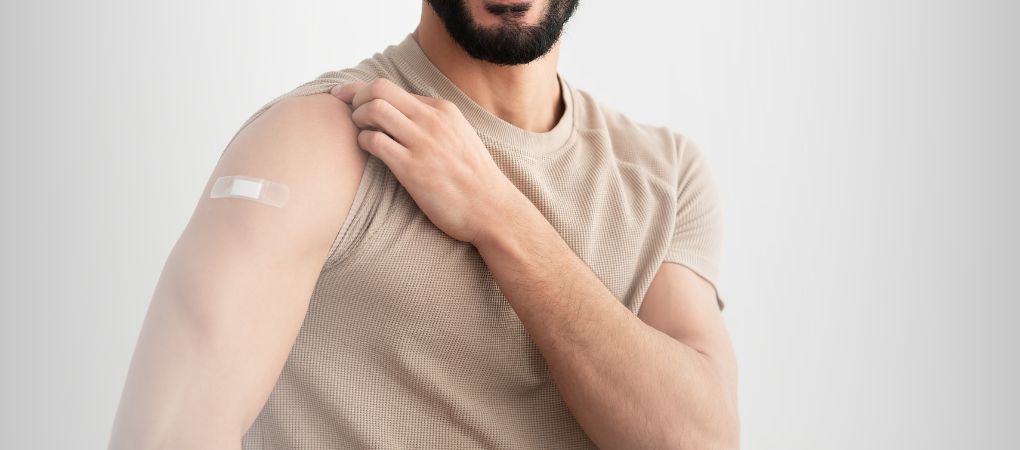Redazione
|
19/12/2023 - Last update 19/12/2023
Sylvia Marshall, Sara Winter, John D Capobianco | Year 2022
Lymphatic osteopathic manipulative treatment reduces duration of deltoid soreness after Pfizer/BioNTech COVID-19 vaccine
Pathology:
Vaccine reactions
Type of study:
Case Report
Date of publication of the study’:
2022/Jan/12

Purpose of the study
- Objective: to report the usefulness of OMT in reducing deltoid muscle soreness after Covid-19 vaccination with Pfizer/Biontech
- Measured outcomes: pain assessment according to a scale from 0 (no pain) to 10 (extreme pain)
Participants
- Number: 1
- Description: a 58-year-old man. Previous medical history without significant events, arrived at the OMT clinic complaining of left shoulder pain after receiving the first dose of Pfizer vaccine for Covid-19.
The pain increased gradually and began about 5 hours before the osteopathic visit. On a scale of 0 (no pain) to 10 (extreme pain), the pain was 0 at rest and 8 during movement. It was a dull, muscle soreness-like pain, nonradiating, but constant and increased by shoulder abduction.
The patient did not take any medication or resort to other remedies such as ice or bandages. He reported no fever, chills, night sweats, malaise and was not feverish to touch. At the site of vaccine injection, no erythema, edema, or induration was present
Physical evaluation of the deltoid muscle revealed tender and swollen skin (possibly due to subcutaneous fluid accumulation) and reduced range of motion (ROM). Whereas palpation identified a tissue congestion in the left anterior axillary region and a flexed superior thoracic inlet with FSLRL.
Interventions and evaluations
- Assessment at the beginning of the visit, immediately after treatment, and 3 hours after pain treatment according to a scale of 0 to 10
- 1 OMT session
- OMT: direct treatment to the left side of the body (the vaccination side), except for the superior thoracic inlet, treated on both sides
- Techniques used: supine thoracic inlet release by balanced ligamentous tension (BLT); anterior axillary fold release; upper-extremity lymphatic pump technique; Spence’s lymphatic pump technique (step 7); thoracic duct siphoning
- Education on the usefulness of OMT in conjunction with standard therapy (application of heat or cold, analgesics, and movement)
- OMT performed by a 3rd year student supervised by a certified osteopath
Results
After OMT, the superior thoracic inlet was more symmetrical, and palpation of the left anterior axillary region revealed less congestion.
Immediately after OMT, pain was described as 2 out of 10 during left shoulder abduction.
At the follow-up telephone call, 3 hours after OMT, the patient reported a reduction of pain to 0, and also stated that he felt more confident and calm than before the visit.
At the following call, 3 weeks later, the patient reported that he had received the second dose of the vaccine and that he would request an OMT if needed.
Discussion
OMT has probably been shown to act on the acute inflammatory and nociceptive reaction elicited by Covid-19 vaccine injection. Although necessary to induce immune memory, locally vaccination promotes an increase in inflammatory molecules that may stimulate nociception and, thus, promote pain and reduce the motility of the injection.
Increased nociception and inflammation can induce a state of myofascial stress that can adversely affect the lymphatic pathways that permeate the body, congesting them. This congestion, in turn, can lead to alterations in the state of myofascial tension, thus creating a vicious cycle.
Therefore, by acting on the release of fascial tension, OMT can promote the restoration of good lymphatic flow – this is one of the basic principles of OMT – which is useful in draining any inflammatory excess, including the one potentially induced by injection, even in a short time (1-2 days).
Lymphatic drainage techniques tend to be safe, effective, and well tolerated, an element that makes it easy to apply them to different patients as well.
Since this is a case report, it is not possible to establish a cause-and-effect link between OMT and the result obtained, just as it is difficult to tell whether it was a specific technique or the whole protocol that worked.
The review of Osteopedia
By Marco Chiera
Strengths: interesting result on an adverse effect that is “secondary” to others of stronger magnitude, but which can linger over time and be bothersome; accurate description of techniques used, useful inorder to reproduce the treatment; good discussion in regard to the lymphatic system; major limitations well pointed out; interesting result considering that the operator was a student.
Limits: as reported by the authors, the case report is not generalizable; given that post-injection pain is a very subjective adverse effect, on which fear or attention can have a strong negative impact – the nocebo effect – it is difficult to say whether OMT really did have an effect from a technical standpoint, or whether it helped “only” because the patient felt reassured.

Are you an osteopath?
Register and enjoy the membership benefits. Create your public profile and publish your studies. It's free!
Register now
School or training institution?
Register and enjoy the membership benefits. Create your public profile and publish your studies. It's free!
Register now
Do you want to become an osteopath? Are you a student?
Register and enjoy the membership benefits. Create your public profile and publish your studies. It's free!
Register now







